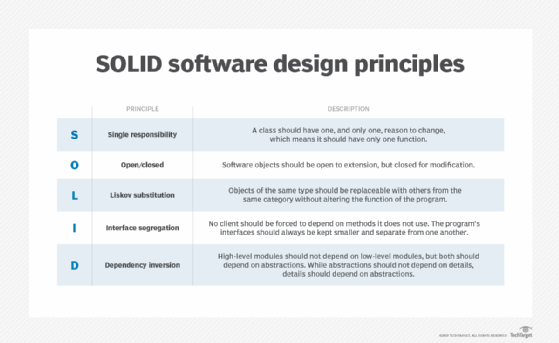

- #Solid principles tutorial upgrade#
- #Solid principles tutorial software#
- #Solid principles tutorial code#
#Solid principles tutorial code#
Maintaining loose coupling limits the impact that the OCP has if you allow modifications to existing code that do not force further changes to clients.Ģ.2. For example, Spring 5 supports and uses Java 8 lambda syntax but to use it, we do not require to change our client application code.Ī module where classes are loosely coupled, a class change without forcing other classes to change and that’s why loose coupling is encouraged.
#Solid principles tutorial upgrade#
This allows the upgrade of the module versions with new language features.

This must be achieved despite modules being closed to modification.

DiscussionĪccording to definitions cited above, for code to be open for extension, developers must be able to respond to changing requirements and support new features. The binary executable version of the module, whether in a linkable library, a DLL, or a Java. In other words, we are able to change what the module does.Ĭlosed for modification – Extending the behavior of a module does not result in changes to the source or binary code of the module. As the requirements of the application change, we are able to extend the module with new behaviors that satisfy those changes. Open for extension – This means that the behavior of the module can be extended.
#Solid principles tutorial software#
Martin has defined the OCP in his book, Agile Software Development: Principles, Patterns, and Practices (Prentice Hall, 2003), as follows: Software entities should be open for extension, but closed for modification. The Meyer definitionīertrand Mayer, in his 1988 book, Object-Oriented Software Construction (Prentice Hall), defined the open/closed principle (OCP) as follows: There are two popular definitions to describe this principle – 1.1. It is one of famous 5 solid principles and very important object oriented design principle. NET developers learn and internalize Design Patterns.The open/closed principle (OCP) states that a module should be open to extension but closed for modification. Does anyone have other experiences or opinions? At least that is how my educational & career process evolved. It seems to me that you need a good grasp of the SOLID principles before you're ready to tackle Design Patterns (in more of an Architect role). You'll find a fair amount of information on the web on these principles. DIP The Dependency Inversion Principle - depend on abstractions not on concrete implementations.ISP The Interface Segregation Principle: - make fine grained interfaces that are client specific.LSP The Liskov Substitution Principle: - derived classes must be substitutable for their base classes.OCP The Open Closed Principle: - you should be able to extend a class's behavior, without modifying it.SRP The Single Responsibility Principle: - a class should have one, and only one, reason to change.I was reading the other day a discussion on Design Patterns versus Design Principles called SOLID.įor those who are not aware of this, SOLID is an acronym for the first 5 principles of object-oriented design:


 0 kommentar(er)
0 kommentar(er)
